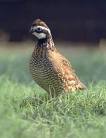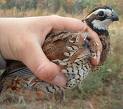The heavy hand of man is destroying the grassland habitat vital to the survival of the northern bobwhite, at left, whose northern range includes Pennsylvania.
Being trend setters here at The Thin Green Line, we are sometimes slow to recognize trends we haven't set.
So after having suggested our army of readers participate in the National Audubon Society's Christmas Bird Count, we began to wonder what kind of numbers in might produce.
The gist of the announcement was summed up with uncommon directness (for a government document): "nearly a third of the nation's 800 bird species are endangered, threatened or in significant decline due to habitat loss, invasive species, and other threats."
We may be math-phobic here at TTGL, but we suspect that one-third is a pretty big number to be endangered.
In addition to being pretty, singing sweetly and crapping all over your just washed car, birds are like frogs in that they are a bellwether of their environment. (There was a reason they had canaries in coal mines and it wasn't to add a dash of color to the gloom.)
The threats are primarily two-fold, invasive species and loss of habitat.
Invasive species are among the primary threats in Hawaii, where ground-dwelling birds that formerly had no predator now fall victim to rats, brought from ships, and cats brought in to control the rats. (It is the absurdity of the situation as much as the rhyming that reminds us of Dr. Suess here).
The thing over which we should have more control is the loss of habitat. The habitat most at risk these days is grassland. Having gotten religion on wetlands, many of those species are making a comeback as a result of conservation efforts.
But while it's not too hard to convince a builder not to erect a house in the middle of a swamp, it's harder when the property is grassland, seemingly perfect for a row of McMansions.
Which is why the northern bobwhite is among the more threatened species, highlighted in Salazar's release about the new bird population report.
This is nothing new to Pennsylvania hunters.
Among other things, it noted "Pennsylvania has lost 1.1 million acres of farmland since the 1960s. Since that time, major declines have occurred in almost all groups of grassland-associated wildlife. A high proportion of the declining bird species in Pennsylvania are associated wi

th grasslands. Nearly 90 percent of grassland birds monitored by the Breeding Bird Survey (BBS) show declines; 43 percent of all grassland species show significant declines while none show significant increases in the state since 1980. In Pennsylvania, species such as the grasshopper sparrow, vesper sparrow, bobolink, eastern meadowlark, northern bobwhite quail, and ring-necked pheasant have declined by 80 percent or more since the mid 1960s.
Don't test us or anything, but we're pretty sure 80 and 90 percent is even more than one-third.
Call us crazy, but this looks like it could be a trend....
Labels: bird count, National Audubon Society, northern bobwhite, Pennsylvania Game Commission, Salazar
 th grasslands. Nearly 90 percent of grassland birds monitored by the Breeding Bird Survey (BBS) show declines; 43 percent of all grassland species show significant declines while none show significant increases in the state since 1980. In Pennsylvania, species such as the grasshopper sparrow, vesper sparrow, bobolink, eastern meadowlark, northern bobwhite quail, and ring-necked pheasant have declined by 80 percent or more since the mid 1960s.
th grasslands. Nearly 90 percent of grassland birds monitored by the Breeding Bird Survey (BBS) show declines; 43 percent of all grassland species show significant declines while none show significant increases in the state since 1980. In Pennsylvania, species such as the grasshopper sparrow, vesper sparrow, bobolink, eastern meadowlark, northern bobwhite quail, and ring-necked pheasant have declined by 80 percent or more since the mid 1960s. RSS
RSS


